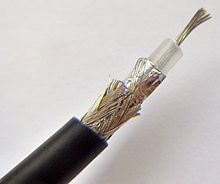
Back خط نقل Arabic Предавателна линия Bulgarian Dalekovodni kabel BS Línia de transmissió Catalan Přenosové vedení Czech Transmissionslinje Danish Leitungstheorie German Ενσύρματο δίκτυο Greek Línea de transmisión Spanish خط انتقال FA


In electrical engineering, a transmission line is a specialized cable or other structure designed to conduct electromagnetic waves in a contained manner. The term applies when the conductors are long enough that the wave nature of the transmission must be taken into account. This applies especially to radio-frequency engineering because the short wavelengths mean that wave phenomena arise over very short distances (this can be as short as millimetres depending on frequency). However, the theory of transmission lines was historically developed to explain phenomena on very long telegraph lines, especially submarine telegraph cables.
Transmission lines are used for purposes such as connecting radio transmitters and receivers with their antennas (they are then called feed lines or feeders), distributing cable television signals, trunklines routing calls between telephone switching centres, computer network connections and high speed computer data buses. RF engineers commonly use short pieces of transmission line, usually in the form of printed planar transmission lines, arranged in certain patterns to build circuits such as filters. These circuits, known as distributed-element circuits, are an alternative to traditional circuits using discrete capacitors and inductors.